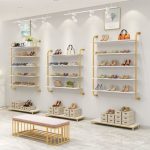Creating visually appealing retail clothing displays is essential for attracting customers and enhancing their shopping experience. In today’s competitive retail landscape, innovative and engaging displays can make the difference between a casual browser and a loyal customer. Here are ten creative clothing display ideas that can elevate your retail space, each expanded to provide you with comprehensive insights and practical tips for implementation.
1. Mannequin Magic
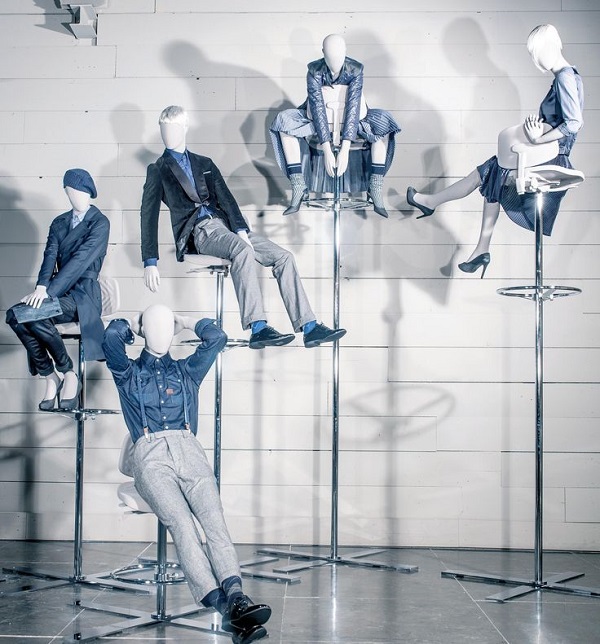
Utilizing mannequins effectively can transform a store’s atmosphere, turning it from a simple clothing repository into a dynamic fashion showcase. Instead of relying on standard, static poses, opt for dynamic, lifelike mannequins that reflect your brand’s identity and energy. Position them in active stances or relatable scenarios, such as lounging in a café, walking briskly as if late for a meeting, or enjoying a day at the park. This approach helps customers envision themselves in the outfits, creating a personal connection with the clothing.
To maximize the impact of your mannequin displays:
- Incorporate diverse body types, ages, and styles to ensure inclusivity and resonate with a broader audience. This not only reflects real-world diversity but also helps various customer segments see themselves represented in your brand.
- For seasonal collections, consider dressing mannequins in themed outfits that tell a cohesive story. For example, create a “summer getaway” scene with mannequins dressed in resort wear, complete with accessories like sunglasses and beach bags.
- Experiment with unconventional poses or groupings. A family of mannequins showcasing a coordinated look can appeal to shoppers looking to outfit multiple family members.
- Regularly update your mannequin displays to keep the store looking fresh and to highlight new arrivals or promotions. This gives repeat customers a reason to explore your store anew with each visit.
2. Floating Garment Displays
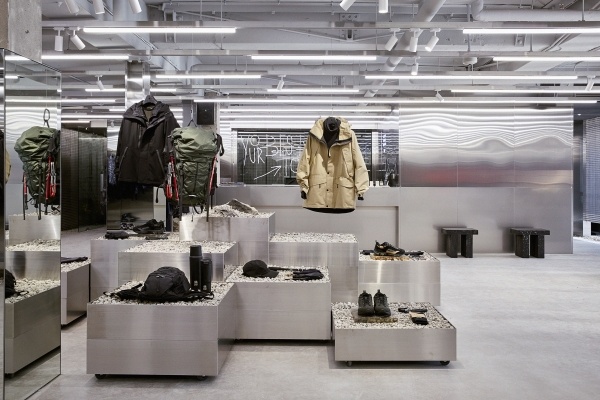
Create an enchanting visual experience by suspending clothing from the ceiling using clear fishing lines or decorative rods. This “floating” effect draws attention upward, adding a whimsical and ethereal touch to your display while maximizing the use of vertical space. It works particularly well for lightweight items like dresses, scarves, or flowing blouses, allowing customers to see the garments from multiple angles without cluttering the floor space.
To create effective floating clothing displays:
- Use a mix of heights to create depth and interest. Varying the levels at which items are suspended can create a cascading effect that guides the eye through the display.
- Pair this clothing display technique with soft, directional lighting to enhance the ethereal feel. Spotlights or string lights can cast gentle shadows and highlights, making the floating garments a focal point in your store.
- Consider the flow of air in your store. Gentle movement of the suspended items can add to the magical effect, but too much motion might be distracting. Use weights or secure fastenings if needed to control movement.
- Rotate the items in your floating display regularly to keep it fresh and to showcase different pieces from your collection. This can be especially effective for highlighting seasonal transitions or new arrivals.
- Complement the floating items with ground-level displays that tell a cohesive story. For example, if you’re floating summer dresses, create a beach-themed display below with sandals, bags, and accessories.
3. Themed Seasonal Clothing Displays
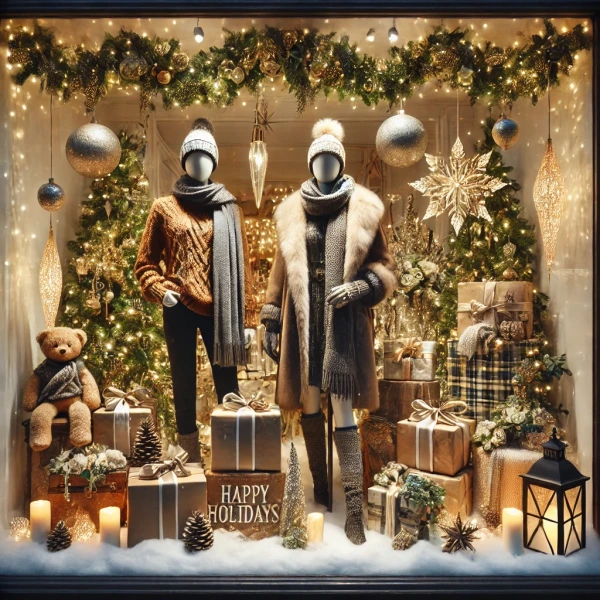
Seasonal themes can significantly influence customer engagement, creating an immersive shopping experience that changes throughout the year. Design clothing displays that reflect holidays, seasonal changes, or cultural events to keep your store fresh and relevant. This approach not only highlights new arrivals but also creates a memorable shopping experience that encourages repeat visits.
To create impactful themed seasonal clothing displays:
- Plan your themes well in advance, aligning them with your inventory to ensure a seamless integration of products and display elements.
- Use props creatively to enhance the seasonal atmosphere. For autumn collections, incorporate elements like artificial autumn leaves, pumpkins, and warm-toned fabrics. For summer wear, create a beach or tropical paradise with sand, seashells, and vibrant colors.
- Extend the theme beyond just visual elements. Consider incorporating scents (e.g., cinnamon for fall, fresh linen for spring) and appropriate background music to create a multi-sensory experience.
- Create interactive elements within your seasonal clothing displays. For instance, a winter-themed display could include a photo booth with a snowy backdrop where customers can try on and photograph themselves in winter accessories.
- Rotate smaller elements of your seasonal display regularly to maintain interest for frequent shoppers. This could involve changing window displays weekly or updating accent pieces throughout the store.
- Use seasonal themes as an opportunity to cross-merchandise. For example, in a summer beach theme, pair swimwear with cover-ups, sunglasses, and beach bags to encourage multiple purchases.
4. Interactive Elements
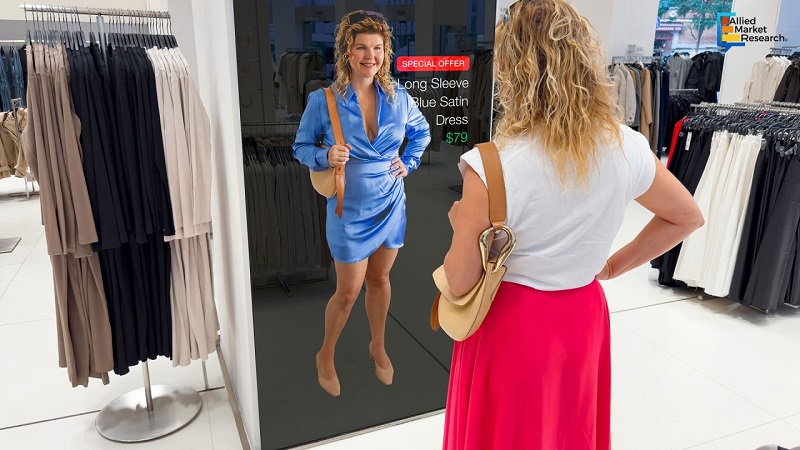
Incorporating interactive retail clothing displays where customers can engage with products transforms passive browsing into an active, memorable experience. This hands-on approach fosters creativity, personal connection to the products, and increases the likelihood of purchase by allowing customers to envision how items fit into their lives.
To create effective interactive elements in your store:
- Set up a “style your outfit” station with various accessories and clothing items that shoppers can mix and match. Provide a full-length mirror and encourage customers to try different combinations. This not only entertains but also educates customers about versatile styling options.
- Implement digital kiosks or tablets where customers can browse extended inventory, check sizes, or view styling suggestions. This bridges the gap between online and in-store shopping experiences.
- Use QR codes linked to styling tips, product information, or videos showcasing how to wear certain pieces. Place these codes near relevant items or displays to provide instant access to additional content.
- Create a social media-friendly photo booth or backdrop where customers can take pictures wearing your products. Encourage sharing with a branded hashtag to increase online visibility.
- Offer personalization stations where customers can customize products, such as adding patches to denim or monogramming accessories. This adds value and creates a unique shopping experience.
- Host in-store events like styling workshops, fashion shows with customer models, or DIY sessions related to clothing care or upcycling. These events create community and position your store as a fashion resource, not just a point of sale.
5. Upcycled Displays
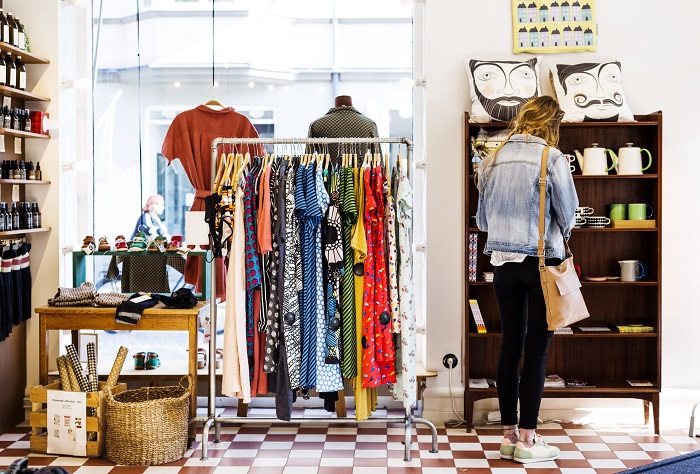
Embracing sustainability by creating clothing displays from upcycled materials not only reduces waste but also adds unique character to your store. This approach resonates with environmentally conscious consumers and can enhance your brand image as responsible and innovative. Upcycled displays offer a perfect blend of creativity, sustainability, and visual appeal.
To effectively incorporate upcycled clothing displays:
- Transform old furniture into unique clothing racks or shelving units. For example, an antique ladder can become a tiered display for folded sweaters, or a vintage dresser with drawers removed can showcase accessories.
- Use wooden pallets to create modular, adjustable wall displays. Paint them in colors that complement your brand aesthetic and use them to hang clothing or as shelves for folded items and accessories.
- Repurpose vintage suitcases or trunks as display stands for smaller items like jewelry, scarves, or folded t-shirts. Stack them to create varying heights and visual interest.
- Convert old doors or windows into unique backdrops for mannequins or as frames for hanging delicate items like scarves or ties.
- Utilize industrial elements like pipes and fittings to create custom clothing racks that add an urban, modern feel to your space.
- Incorporate eco-friendly materials like bamboo or reclaimed wood for signage or display bases to further emphasize your commitment to sustainability.
- Create an educational component by including small placards that explain the origin of upcycled pieces, highlighting your store’s commitment to reducing waste.
6. Color Coordination
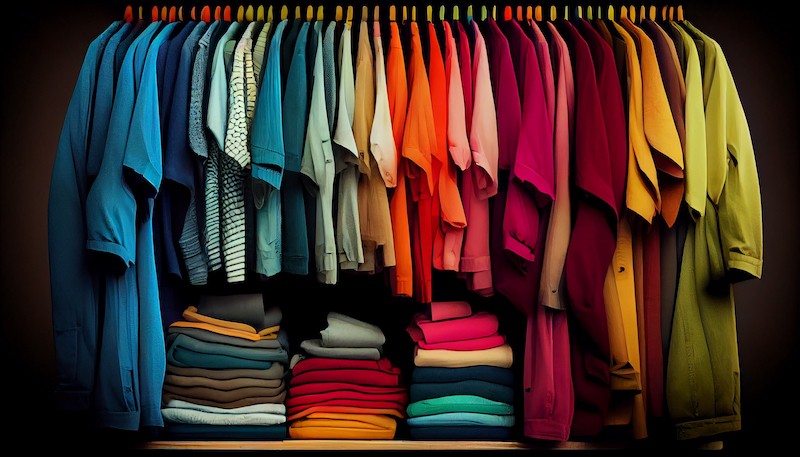
Organizing clothing by color creates a visually striking display that draws customers in and makes navigation intuitive. This method allows shoppers to easily find items that match their preferences while creating a harmonious look throughout the store. Color coordination can be a powerful tool in visual merchandising, influencing mood and purchasing decisions.
To effectively use color coordination in your clothing displays:
- Create a color story that flows through your store. Start with lighter shades and gradually move to darker ones, or group complementary colors together to create visually pleasing sections.
- Use gradient arrangements to showcase the full spectrum of a particular color family. This works especially well for basics like t-shirts or sweaters, creating an ombre effect that’s visually striking.
- Implement bold blocks of color to make specific collections stand out. This can be particularly effective for seasonal promotions or new arrivals.
- Consider the psychology of color in your arrangements. For example, place energetic colors like red or orange in high-traffic areas to attract attention, while using calming blues or greens in areas where you want customers to linger.
- Use color coordination to highlight versatility in your clothing line. Show how different shades of the same color can be mixed and matched to create various outfits.
- Incorporate neutral colors strategically to break up intense color blocks and provide visual relief. This can also showcase how neutral pieces can complement more vibrant items.
- Update your color scheme regularly to reflect seasonal changes or current color trends in fashion. This keeps your store looking fresh and aligned with current styles.
7. Wall-Mounted Displays
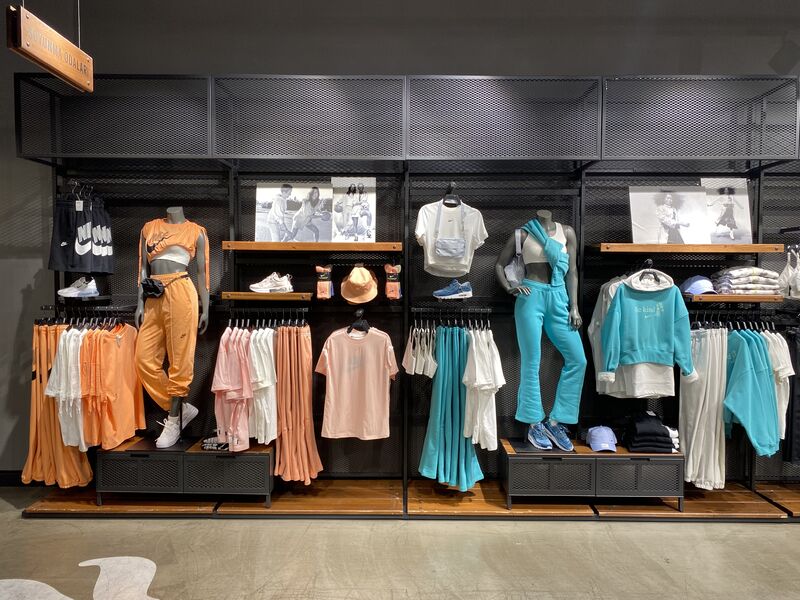
Maximizing floor space by utilizing wall-mounted displays for clothing items is an excellent strategy, especially for smaller stores where every inch counts. This approach provides an organized yet visually appealing way to showcase merchandise while keeping the floor area open for customer movement and additional displays.
To create effective wall-mounted retail clothes displays:
- Use slatwalls or grid panels for versatile arrangements. These systems allow for easy adjustment and rearrangement of items, keeping your displays dynamic and fresh.
- Create depth and interest by hanging items at various heights. This layered approach can make your walls visually engaging and draw the eye to different areas of your display.
- Incorporate shelving units between hanging areas to display folded items, accessories, or decorative elements that complement your clothing lines.
- Use wall-mounted mannequin torsos or busts to showcase tops, dresses, or accessories in a space-saving manner.
- Implement lighting solutions specifically for your wall displays, such as track lighting or individual spotlights, to highlight key pieces and create ambiance.
- Design modular wall units that can be easily reconfigured to accommodate changing inventory or seasonal displays.
- Utilize the space above eye level for branding, signage, or artistic elements that complement your store’s aesthetic without cluttering the main display areas.
8. Lifestyle Vignettes
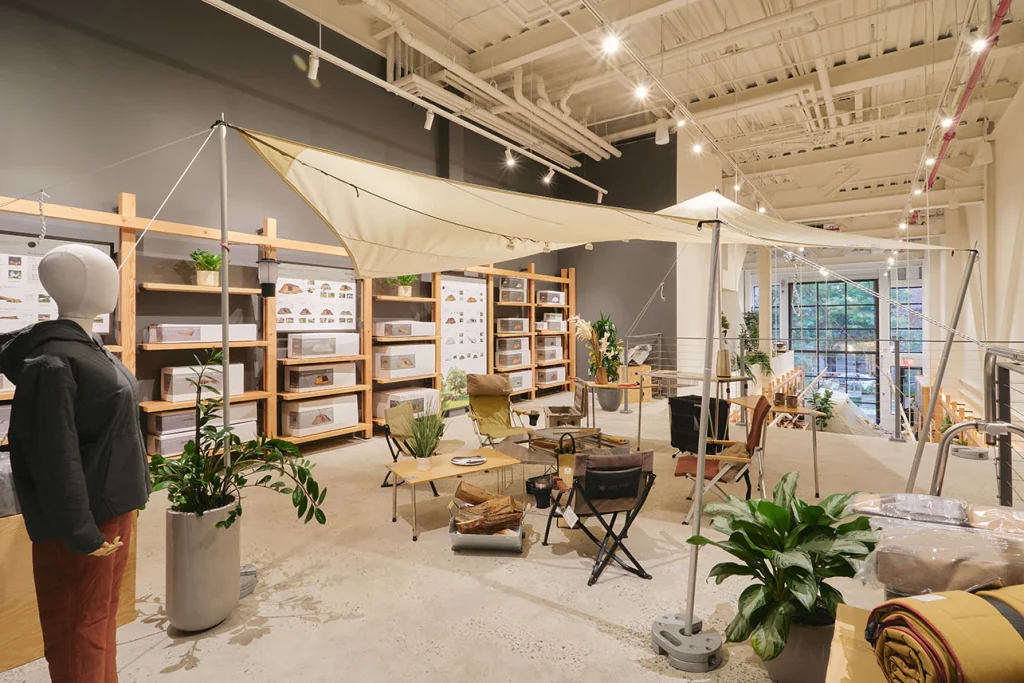
Crafting lifestyle vignettes that depict how your clothing fits into everyday life is a powerful way to connect with customers on an emotional level. These setups help shoppers visualize how they might wear the items in real-life scenarios, making them more likely to purchase. By creating relatable scenes, you’re not just selling clothes; you’re selling a lifestyle.
To create compelling lifestyle vignettes:
- Set up small scenes featuring mannequins or models engaging in relatable activities. For example, create a “work from home” corner with comfortable yet stylish loungewear, or a “night out” scene with elegant evening wear.
- Use props and furniture to enhance the realism of your vignettes. A desk setup for office wear, picnic accessories for casual outdoor clothing, or sports equipment for activewear can help tell a story.
- Rotate your vignettes regularly to showcase different aspects of your clothing line and to keep the store looking fresh for repeat customers.
- Incorporate seasonal elements into your vignettes to make them timely and relevant. A summer barbecue scene or a cozy winter reading nook can highlight appropriate clothing for the season.
- Use lighting to set the mood for each vignette. Soft, warm lighting for a home scene or bright, energetic lighting for a fitness setup can enhance the atmosphere.
- Include lifestyle accessories that complement the clothing, such as bags, jewelry, or shoes. This encourages cross-category purchases and shows customers how to complete a look.
- Create aspirational yet attainable scenes that resonate with your target audience. The key is to strike a balance between inspiration and relatability.
9. Creative Use of Lighting
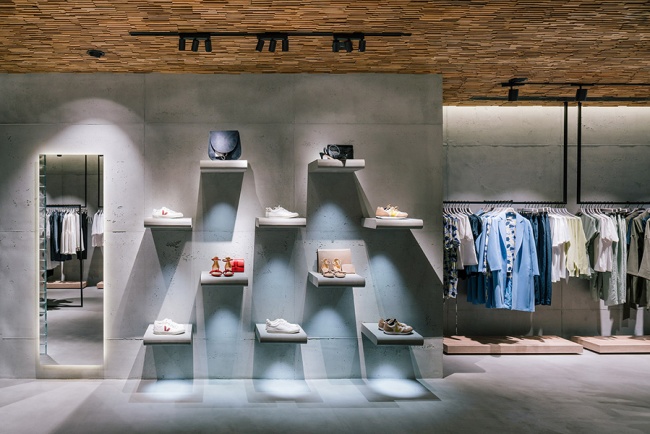
Lighting plays a crucial role in highlighting clothing displays and setting the overall mood of your store. Effective lighting can dramatically change the atmosphere, draw attention to key pieces, and even influence purchasing decisions. By creatively using different lighting techniques, you can enhance the visual appeal of your merchandise and create an inviting shopping environment.
To maximize the impact of lighting in your clothing displays:
- Use spotlights to draw attention to key pieces or new collections. This focused lighting creates visual interest and guides customers’ eyes to specific areas of your store.
- Implement softer, ambient lighting throughout the store to create a welcoming atmosphere. This general lighting ensures customers can navigate comfortably while setting a pleasant mood.
- Experiment with colored lights for seasonal themes or special promotions. For example, warm golden lights for autumn collections or cool blue tones for winter wear can enhance the thematic experience.
- Consider the color rendering index (CRI) of your lights to ensure they accurately represent the colors of your clothing. High CRI lights are essential in areas where color matching is important, such as fitting rooms.
- Use backlighting for dramatic effect, especially in window displays or behind mannequins. This technique can create silhouettes and add depth to your clothing displays.
- Implement adjustable lighting systems that allow you to change the intensity and direction of light throughout the day or for different events.
- Incorporate LED strip lighting in shelving units or along clothing racks to add a modern, sleek look to your clothing displays while providing functional illumination.
- Use natural light where possible, positioning displays near windows to take advantage of daylight. However, be mindful of potential fading of merchandise exposed to direct sunlight.
10. Vintage Inspiration
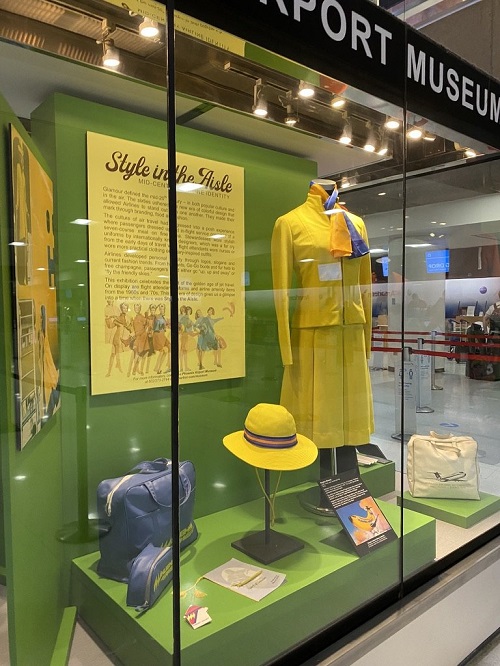
Incorporating vintage elements into your clothing displays can evoke nostalgia and attract customers who appreciate classic aesthetics. This approach adds character to your store and can create a unique shopping experience that sets you apart from more contemporary retailers. Vintage-inspired displays work particularly well for clothing lines that draw inspiration from past eras or for stores looking to create a timeless, eclectic atmosphere.
To effectively use vintage inspiration in your garment displays:
- Source authentic vintage furniture pieces like old dressers, armoires, or vanities to use as display stands. These pieces can add charm and serve as conversation starters.
- Utilize vintage suitcases or trunks as unique platforms for folded clothing or accessories. Stack them at varying heights to create visual interest.
- Incorporate old-fashioned dress forms or vintage mannequins to showcase clothing in a way that bridges past and present styles.
- Use antique mirrors or picture frames to create focal points or to frame smaller display areas within your store.
- Integrate vintage signage or typography in your price tags, labels, or store signage to reinforce the retro aesthetic.
- Create themed sections that reflect different decades, allowing customers to explore various vintage-inspired looks.
- Mix vintage display elements with modern clothing to create an interesting juxtaposition that highlights the timelessness of fashion.
- Use vintage-style lighting fixtures, such as Edison bulbs or antique lamps, to enhance the overall ambiance.
- Incorporate vintage accessories like old cameras, typewriters, or radios as props to complement your clothing displays and add authenticity to your vintage theme.
Conclusion
In conclusion, these ten innovative display ideas offer a comprehensive approach to elevating your retail space. By combining visual appeal, customer engagement, and strategic merchandising, you can create an immersive shopping environment that not only showcases your products effectively but also tells a compelling brand story. Remember, the key to successful retail displays is continuous evolution – regularly update and refresh your displays to keep customers intrigued and coming back for more. With creativity and attention to detail, your store can become a destination that customers look forward to exploring time and time again.
More Posts:
20 Retail Window Display Ideas for Visual Merchandising
Window Displays: Ultimate Guide
10 Outstanding Merchandise Display Examples



